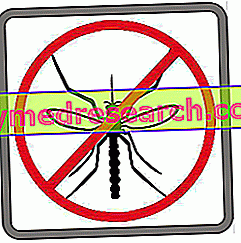Antivirals are drugs used to treat infections caused by viruses.
Viruses
Viruses are very small infectious agents. They cannot be considered microorganisms, since they consist only of proteins and of a single type of nucleic acid (DNA or RNA, which can be either double-stranded or single-stranded); furthermore, they lack their own motility.

For these reasons, viruses are called " obligate cell parasites ". Their structure is such as to guarantee protection from the external environment and to allow them to penetrate inside the host cells.
Viruses can be divided according to the nucleic acid that constitutes them, therefore, they are distinguished:
- DNA viruses ; among the viruses belonging to this class we recall; Parvoviruses, Papillomaviruses, Hepadnaviruses and Herpesviruses;
- RNA viruses ; some of the viruses belonging to this class are the Caliciviruses, the Flaviviruses and the Retroviruses.
Antiviral therapy
The goal of antiviral therapy is to interfere in the biological viral processes that are absent in the host cell (which for this reason is not damaged).
The first antiviral drugs to be discovered did not possess a sufficient selectivity, were toxic already at therapeutic concentrations and possessed a rather reduced spectrum of action.
The antiviral drugs currently marketed are instead able to counteract the viruses, but often they cannot completely eradicate the infection.
Furthermore, the symptoms of viral infection can only occur after the virus has completed its replication and only after its genome has been internalized within the host cell; this makes it even more difficult to identify and synthesise truly effective antiviral drugs capable of completely destroying the virus. In fact, once the virus has invaded the host cell and started its replication, the infection is difficult to cure.
Virus vaccines are effective, but they are only effective against certain types of strains. For this reason, the research aims to obtain antivirals with a broader spectrum of action and greater efficacy.
The ideal antiviral drug should have the following characteristics:
- Have a broad spectrum of action;
- Being able to totally inhibit viral replication;
- Be effective also against mutant strains;
- Reach the target organ without interfering with the biological processes of the host organism;
- Do not interfere with the immune system of the host organism.
Classification of antiviral agents
The viral agents currently on the market can be classified into various groups, depending on their mechanism of action.
Below, these groups will be briefly listed.
Inhibitors of the early stages of viral replication
The antiviral drugs belonging to this group exert their action by interfering with the first stages of viral replication, such as the adhesion of the virus to the receptors of the host cell, the penetration into the same and the loss of the viral coating.
Amantadine and rimantadine are part of this group.
Neuraminidase inhibitors
Neuraminidase is an enzyme expressed above all on the surface of influenza viruses and plays an important role in the activation of new viruses and their release from the host cell.
Zanamivir and oseltamivir belong to this group of antivirals.
Agents that interfere with the replication of viral nucleic acid
As you can guess from the name of this group, the drugs that belong to it are able to inhibit the synthesis of the nucleic acid of the virus (DNA).
These drugs have a chemical structure very similar to that of the nitrogenous bases that make up the DNA and - thanks to their similarity - are incorporated into the DNA strand of new synthesis, thus blocking its growth.
Aciclovir, famciclovir, cytarabine (also used as an anticancer drug), ganciclovir, trifluridine and idoxuridine belong to this category of drugs.
Antiretroviral (or anti-HIV) agents
The HIV virus is responsible for the acquired human immunodeficiency (better known as AIDS).
HIV is a Retrovirus, which is a particular type of RNA virus.
In order to replicate, this virus requires the conversion of its RNA into DNA; this conversion takes place thanks to a particular enzyme, the reverse transcriptase .
Some anti-HIV agents act by inhibiting the reverse transcriptase. Among these inhibitors are zidovudine, didanosine, zalcitabine, lamivudine and stavudine .
Other antiretroviral agents work by inhibiting the HIV protease, a key enzyme for virus growth.
Ritonavir and indinavir are protease inhibitors.
Protease inhibitors can be administered in combination with reverse transcriptase inhibitors to try to improve therapy efficacy.



